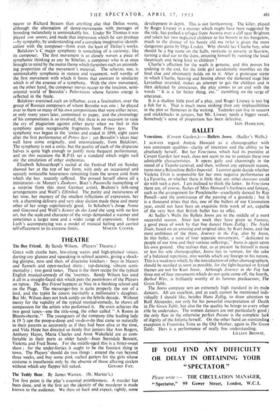BALLET
Veneziana. (Covent Garden.)—Ballets Jooss. (Sadler's Wells.) I ALWAYS regard Andree Howard as a choreographer with two consistent qualities—clarity of intention and the ability to be absolutely herself. But her Veneziana, which had its premiere at Covent Garden last week, does not seem to me to contain these two admirable characteristics. It opens gaily and charmingly in the mood of a Tiepolo carnival; and then, without any apparent reason, turns into a Balanchine Ballet Imperial. I cannot quite decide whether Violetta Elvin is responsible for her own negative performance as La ravorita, or whether there is little that any other danseuse could do with such a part. I am inclined to think the latter. In Veneziana there are, of course, flashes of Miss Howard's freshness and fantasy, such as the arrangement for Punchinello—excellently danced by Ray Powell—and the contrivance of the passing of a gondola ; but it is a thousand pities that this, one of the ballets of our Coronation year, could not have been an exquisite little work of art, capable of the very best that British ballet has to offer.
At Sadler's Wells the Ballets booss are in the middle of a most successful season. Since last week they have given us Fantasy, a good piece of work by that fine dancer Hans Zullig ; The Night Train, based on an amusing and original idea, by Kurt Jooss, and the most ambitious of the three, Journey in the Fog, also by Jooss. In this ballet, a suite of four separate movements, " dedicated to people of our time and their various sufferings," Jooss is again upon his own ground. One realises that, as at present he himself is more or less his sole choreographer, Jooss has to venture, for the sake of a balanced repertoire, into worlds which are foreign to his nature. This is a weakness which, by the introduction of other choreographers, should be rectified as soon as possible, for the light-hearted or lyrical themes are not for Kurt Jooss. Although Journey in the Fog has three out of four movements which do not quite come off, the fourth, Barbed Wire, is brilliantly worthy of its famous predecessor, The Green Table.
The Jooss company sets an extremely high standard in its male dancers. All are excellent, and as each cannot be mentioned indi- vidually I should like, besides Hans Zullig, to draw attention to Rolf Alexander, not only for his powerful interpretation of Death in The Green Table, but also for the quality he brings to every other role he undertakes. The women dancers are not particularly pod 7, the only flaw in the otherwise perfect Pavane is the complete lack of dignity of the Infanta herself. On the other hand an outstanding exception. is Franziska Tona as the Old Mother, again in The Green Table. Hers is a performance of really fine understanding.
LILLIAN BROWSE.
a


































 Previous page
Previous page